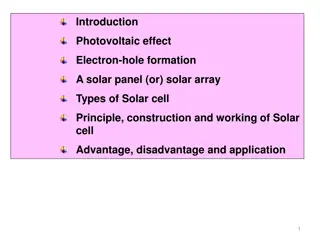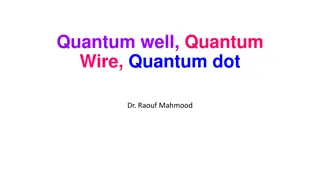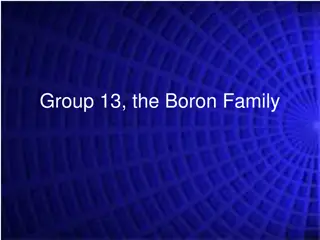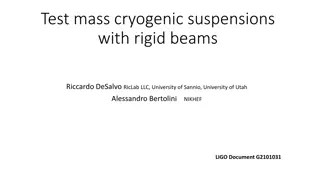Understanding the Basics of Solar Cells: Types, Materials, and Working Principles
Solar cells, also known as photovoltaic devices, convert light energy into electrical energy through the photovoltaic effect. They consist of different generations with varying materials such as crystalline silicon, cadmium telluride, and gallium arsenide. Learn about the construction, working princ
8 views • 32 slides
Understanding Quantum Wires and Nanowires: Properties and Applications
Quantum wires, quantum dots, and nanowires are essential components in nanotechnology due to their unique properties and applications. Quantum wires are one-dimensional systems with restricted electron movement, while quantum dots are zero-dimensional, limiting electron movement in all dimensions. N
3 views • 12 slides
Exploring Group 13: The Boron Family in Chemistry
Discover the elements in Group 13, known as the Boron Family, which includes metals like aluminum and gallium, and the metalloid boron. Learn about their properties, uses in everyday items like cookware and soft-drink cans, and unique characteristics such as gallium's low melting point. Explore how
1 views • 5 slides
Understanding Light Emitting Diodes (LEDs)
Light Emitting Diodes (LEDs) are semiconductor devices that convert electrical energy into visible or invisible light. They are constructed using gallium, phosphorus, and arsenic materials instead of silicon or germanium. The recombination process in forward bias condition is crucial for the operati
0 views • 19 slides
Innovative Solutions for Cryogenic Suspensions Using Compressive Flexure Beams
Test mass cryogenic suspensions with rigid beams pose conflicting requirements, such as thermal noise reduction and vibration attenuation. This study explores the use of compressive flexure beams as a solution to achieve flexibility without sacrificing thermal conductance. Compressional mode flexure
0 views • 13 slides




